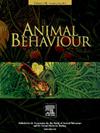Social information use for spatial decision in the common lizard, Zootoca vivipara
IF 2.3
2区 生物学
Q2 BEHAVIORAL SCIENCES
引用次数: 0
Abstract
Individuals' movements are conditioned by the acquisition of information from personal interactions with the environment or from social sources. Despite the importance of social information in movement decision making, little is known about how individuals proceed when social information comes from multiple sources. Here, we specifically tackled this issue by experimentally testing (1) how social information from multiple sources is used to make relocation decisions and (2) whether a contrast in this information enables individuals to orient themselves in space. Using the common lizard as a model species, we conducted repeated experiments in which a focal neonate received information from two other neonates coming from distinct peripheral environments before being given the opportunity to relocate to either peripheral environment. Specifically, we focused on information on resource availability and intraspecific competition by considering informants' body mass (BM) at birth and their subsequent food intake. Our analyses revealed that the amount of resources in the informants' environments affected relocation decisions, depending on the focal individual's phenotype. We found the probability of relocation increased when both the informants' food intake and the focal individual's BM increased or decreased. We also found the relocation increased when both the informants' and focal individual's BM increased or decreased. Our findings suggest that focal individuals adjust their relocation response to social information according to their needs and/or physical abilities. Conversely, we found no significant effect of differences in BM between informants or spatial variability in resource availability on spatial orientation. This study highlights that multiple sources of social information that reflect the quality of the surrounding environment (competition or resource availability) can be used for movement decision making.
普通蜥蜴 Zootoca vivipara 利用社会信息进行空间决策的情况
个体的运动受制于从个人与环境的互动或社会来源中获取的信息。尽管社会信息在迁移决策中非常重要,但人们对个体如何利用来自多个来源的社会信息却知之甚少。在这里,我们通过实验测试了(1)如何利用来自多个来源的社会信息来做出迁移决策,以及(2)这些信息的对比是否能使个体在空间中定位。我们以普通蜥蜴为模型物种,进行了重复实验,在实验中,一个焦点新生个体在有机会搬迁到任何一个外围环境之前,会接收来自其他两个不同外围环境的新生个体的信息。具体来说,我们通过考虑信息提供者出生时的体重(BM)及其随后的食物摄入量,重点研究了有关资源可用性和种内竞争的信息。我们的分析表明,信息提供者所处环境中的资源量会影响迁移决定,这取决于焦点个体的表型。我们发现,当信息提供者的食物摄入量和焦点个体的体重都增加或减少时,迁移的概率就会增加。我们还发现,当信息提供者和病灶个体的生物量都增加或减少时,迁移的概率也会增加。我们的研究结果表明,焦点个体会根据自己的需要和/或体能调整对社会信息的迁移反应。相反,我们发现信息提供者之间的 BM 差异或资源可用性的空间变化对空间定向没有明显影响。这项研究强调,反映周围环境质量(竞争或资源可用性)的多种社会信息来源可用于迁移决策。
本文章由计算机程序翻译,如有差异,请以英文原文为准。
求助全文
约1分钟内获得全文
求助全文
来源期刊

Animal Behaviour
生物-动物学
CiteScore
4.60
自引率
8.00%
发文量
236
审稿时长
10.2 weeks
期刊介绍:
Growing interest in behavioural biology and the international reputation of Animal Behaviour prompted an expansion to monthly publication in 1989. Animal Behaviour continues to be the journal of choice for biologists, ethologists, psychologists, physiologists, and veterinarians with an interest in the subject.
 求助内容:
求助内容: 应助结果提醒方式:
应助结果提醒方式:


